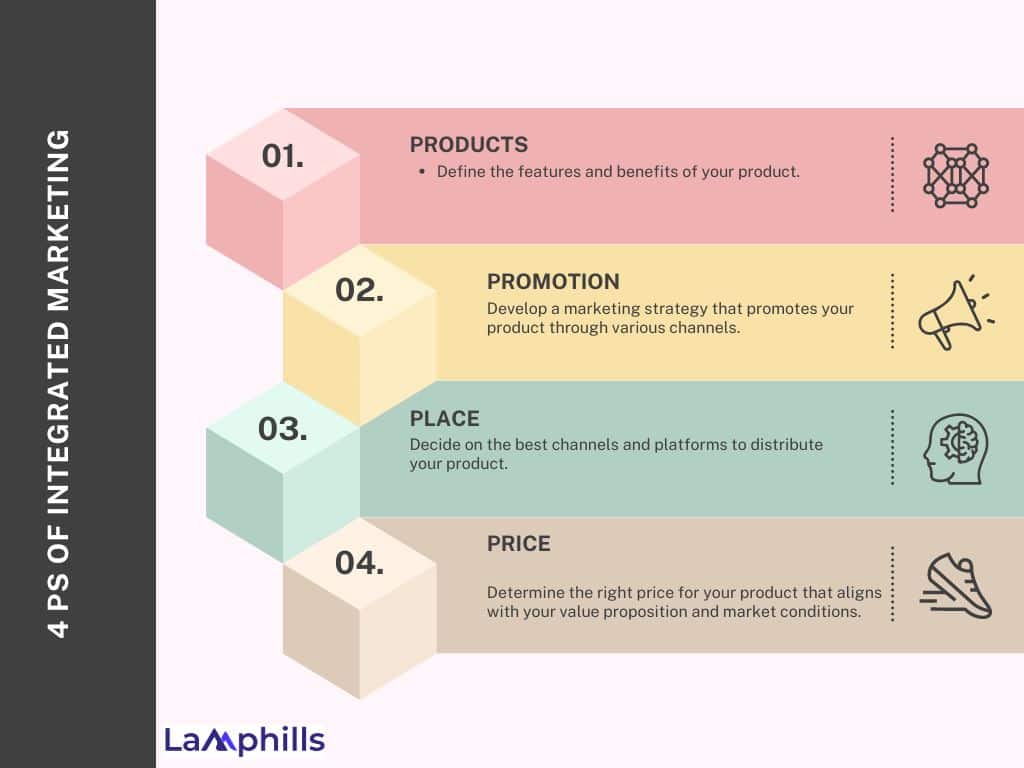How can a business effectively place its marketing message in this day and age of rapid internet expansion, technological advancement, and globalization? Moreover, where should it use diverse media strategies? An integrated marketing campaign is the solution. Evidently, it has become impossible and undesirable to have a single concept of marketing which could be social media or email marketing. For this reason, all marketing initiatives must be combined to provide a consistent message about the company’s brand. Thus, what constitutes a successful integrated marketing campaign?
This article provides information on the essentials of an effective integrated marketing campaign + templates, examples & how to design one for your business using the provided templates.
Key Points
- Effective campaigns prioritize clear and consistent messaging across all platforms, reinforcing brand identity and avoiding audience confusion. A unified message, like Nike’s “Just Do It,” enhances brand recognition.
- Utilizing multiple channels such as social media, email, and traditional advertising allows businesses to engage their audience where they are, increasing interaction and visibility. Brands like Coca-Cola successfully implement this approach to maintain a cohesive message.
- Establishing clear objectives (e.g., brand awareness, lead generation) to guide campaign strategies. Additionally, segmenting the audience enables personalized messaging, catering to the distinct needs and interests of different groups.
- Monitoring campaign performance through analytics helps identify effective strategies for improvement. Furthermore, maintaining a consistent brand identity—through uniform colors, logos, and design—builds trust and enhances brand recognition.
Integrated Marketing Campaigns
The employment of media instruments, such as advertisements, in integrated marketing communication, or IMC, is explored along with the business and marketing strategy of one organization.
To this effect, integrated marketing communication can be defined as a marketing plan that ensures that all communication tools are in harmony with their ultimate aim of delivering a single message to the consumer. The best way to ensure this is to ensure that any contact that the customer has chosen to have with your company or organization whether online or offline, positive or negative, can be long-lasting and memorable.
Takeaway: IMC enhances brand awareness and is particularly effective where the company objectives include proximate and longer-term relationships and consumer interactions.
Jeff Bezos, the founder of Amazon once said, “Your brand is what other people say about you when you are not around. ” Even more, an integrated marketing communication strategy ensures people get the same information about the brand whichever time and place they are exposed to it.
Key Elements of an Effective Integrated Marketing Campaign
Some elements need to be considered in developing effective integrated marketing campaigns. These elements ensure cohesiveness, focus on the campaign, and maximize its design for high impact.
#1. Clear and Consistent Messaging

Consistency and clear messaging in an integrated marketing campaign are the building blocks of how a marketer can portray a message loudly and clearly. A message, that remains the same across the board, is the only way to avoid confusion within your audience and to help fortify brand recognition.
See: What Is Brand Storytelling and Why It Matters for Your Brand (+ Examples & Templates)
For instance, the famous Nike slogan of “Just Do It” remains the same whether in a television advertisement, an online marketing banner, or various other forms. This uniformity makes the brand recognizable to customers, whether on a highway billboard or next to a sports sponsorship event.
#2. Multi-Channel Approach
One of the key advantages and powers of integrated marketing campaigns is multichannel usage. In other words, whether through social media, email marketing, content marketing, paid advertising, or public relations, businesses need to reach their audience where they are. This multi-channel approach increases the likelihood that your audience views and interacts with your content.
For example, a brand like Coke will run campaigns on television, social media, outdoor billboards, and even in-store promotions—each with the same message but cut to fit the format of that platform.
#3. Defined Goals and Objectives

Your overall integrated marketing campaign has objectives and goals.
What are you trying to do?
Lead Generation?
Drive Sales?
The goals of your campaign will influence the strategies you leverage and the tactics in each channel you use.
For instance, if boosting sales is the main objective, campaign designs would concentrate on aggressive, conversion-based channels like email marketing, PPC ads, and informative blog posts to help customer care.
Read also: How to Write the Best Google Ads Copy in 6 Steps: Templates and Examples
#4. Audience Segmentation
Targeting the right audience allows you to create personalized marketing messages.
In this way, you can split your target market into small groups of prestigious people, each having one or more defined psychographics, behaviors, or interests.
You will then tailor a message for each distinctive group within the same campaign more narrowly.
Take for instance a clothing brand. You may have very different messages for teenagers than messages you may have for parents. Although the two segments would appeal to a wide audience, their messages would almost certainly differ due to their varied requirements and areas of interest.
#5. Consistent Brand Identity
Maintaining uniformity in colors, logos, fonts, and overall appearance throughout all marketing channels is known as brand identity consistency.
This is consistent because it will bring trust to the viewers and escalate the brand’s recognizability.
Consider Apple as an example; by all accounts, its design is intricately basic. It is applied in all the company’s materials such as TV commercials, web banners, and package elements.
#6. Analytics and Measurement.

You can’t improve what you don’t measure.
Once your campaign is live, it’s important to track its performance to understand what’s working and what isn’t.
This is made possible through the use of analytics tools in measuring a campaign’s effectiveness across different channels. For example, it can show you the number of people who click on your email links or act on your social media posts, hence identifying the best working channels to improve your efforts.
Check out: 10+ SEO Automation Tools That Boost Efficiency
Integrated Marketing Campaign Examples
Let’s look at successful integrated marketing campaigns that have made quite a difference.
#1. Coca-Cola’s “Share a Coke” Campaign
One of the best classics of integrated marketing campaigns is the Coca-Cola “Share a Coke” campaign. This iconic brand basically reversed its world-famous logo on Coke bottles with the most common names people go by.
The campaign extended to TV, social media, personalized digital experiences, and in-store promotions to encourage consumers to share a Coke with someone whose name was on the bottle.
The message was simple, personal, and ‘on-message’ across all channels. With this multichannel, Coca-Cola strived to increase brand engagement and raise sales effectively.
#2. Old Spice “The Man Your Man Could Smell Like”
In 2010, Old Spice ran one of the greatest integrated campaigns of the decade, with the ad “The Man Your Man Could Smell Like”.
What started as a sidesplitting TV commercial soon rolled out over social media, where Old Spice was engaging with its audience directly.
Over 180 personalized video responses were scripted, shot, and uploaded to YouTube, Twitter, and Facebook – keeping the campaign hot off the press or editing suite.
The consistent brand messages and playful tones from one platform to the next—whether in traditional TV advertising or online content—achieved high brand awareness and record sales.
#3. Always “#LikeAGirl” Campaign
Always’ “#LikeAGirl” commercial tackled gender stereotypes by asking what it means to do things “like a girl.” The campaign featured a compelling video that gained widespread attention on social media and was advertised on television and online. The coherence of the communication on all media, ridden with an equally strong emotional appeal, created a lot of buzz and made the brand easily identifiable.
This integrated approach of boosting the brand identity of Always, at the same time supporting a socially relevant cause, made the brand even more significant.
#4. Dove’s “Real Beauty” Campaign
What better example of integrated marketing than the Dove “Real Beauty” campaign, which connected with audiences?
The concept in this advertisement relies on challenging beauty standards by celebrating natural beauty and shifting the focus toward empowering women to be confident in their skin.
With the Dove Campaigns for Real Beauty, the identical message resounded in each medium: television and social media commercials, print ads, and public relations work. A viral video, like “Real Beauty Sketches,” becomes an overnight sensation on YouTube and then echoed on other spaces, such as Facebook and Twitter, to generate further buzz about the content. This harmony has been effective in creating an emotional connection with the people thereby increasing brand loyalty and sales.
Key Components:
Real Women, Real Beauty: Rather than using professional models, the ad highlighted genuine women of all ages, shapes, and races. This sincerity sought to convey the variety of beauty.
Dove has made several captivating videos that explore the concept of beauty. They include talks and interviews with the female campaign participants. Both traditional and online advertising channels were used to distribute these movies. To support girls and young women’s good body image and self-esteem, Dove held educational seminars and programs in schools and communities in addition to the films.
The campaign shared photographs and tales of actual women on social media and digital platforms, encouraging conversations on beauty standards. The content was collected using the hashtag #RealBeauty.
#5. Red Bull “Stratos” Campaign
Red Bull’s “Stratos” campaign is a perfect example of how an integrated marketing campaign can create a brand identity through a combination of content and experience: Red Bull sponsored skydiver Felix Baumgartner in a record-breaking free-fall from the stratosphere, an event that was televised live across numerous channels.
The campaign involved live TV broadcasting and reached out through all social media, such as YouTube and Facebook, as well as interactive online content. Red Bull also combined its campaign with traditional print ads and outdoor billboards.
The motto was set for all to see: Red Bull gives you wings. It made billions of media impressions and supported Red Bull’s identity as a much larger than just an energy drinks brand.
#6. The “Wrapped” Campaign
Spotify’s “Wrapped” campaign exemplifies how to properly integrate marketing efforts across multiple channels. Year after year, Spotify creates a personalized, shareable story for every user that unfolds a great summary. Users have directly shared this campaign as a year-end affair through notifications via email and on the Spotify app dashboard. Spotify also encourages users to share their Wrapped stories on social media—something that adds to the virality. Besides, Spotify promotes Wrapped using digital ads, podcasts, and billboards.
By personalizing the content and encouraging user interaction, Spotify makes the campaign feel unique to each person while keeping its messaging and branding consistent across all platforms. It makes the rendition very personal and inviting for the users making it feel very specifically exciting.
#7. Airbnb’s “We Accept” Campaign
Airbnbs “We Accept” campaign was launched in response to growing global tensions around immigration and inclusivity. It valued the important idea that Airbnb allowed people from all walks of life, regardless of race, religion, or background.
The channels used to spread the campaign included a Super Bowl advert, posts on social media platforms, and blog content. Through this campaign, Airbnb shows the company’s stance on being all-inclusive and accepting. The campaign resulted in traction on their page through platforms such as Twitter and Facebook, where there was user-generated engagement with the brand. Customer loyalty increased due to securing Airbnb’s position with inclusivity.
Tip: These integrated marketing campaigns worked because they successfully maintained consistent messaging across all channels. Moreover, by using a variety of platforms and encouraging user interaction, these brands increased their reach and deepened customer engagement. These examples show how, with the right strategy, a unified campaign can make a significant impact across multiple touchpoints.
What Is an Example of Integrated Marketing?
Integrated marketing is any form of marketing campaign that involves several channels while being executed. For example, you might be watching a commercial for a new popular flavor of donuts and then drive by the shop to see donut posters.
What Are the 4 PS of Integrated Marketing?

The four Ps include product, price, place, and promotion. They are an example of a “marketing mix,” or the combined tools and methodologies marketers use to achieve their marketing objectives.
What Is the Primary Goal of IMC?
The vision and mission of integrated marketing communications are to ensure that when customers interact with a firm or company’s brand in one way or another, they get the same message.
How to Create an IMC Campaign?
Creating an IMC Campaign is not easy though it is very successful when done well. These are some of the steps needed to develop an effective IMC Campaign.
- Define your big campaign objective.
- Select marketing channels and set objectives you want to reach with the help of those channels.
- Define your buyer personas by channel.
- Identify your channel managers.
- Develop flexible marketing assets and messaging.
- Define your strategy for capturing leads.
How to Create an Integrated Marketing Communications (IMC) Campaign for Effective Business Strategy and Sales: Here’s a detailed template to guide your IMC campaign:
Conclusion
Congratulations! To reach the final guide on an effective integrated marketing communications campaign. You should now be familiar with the basic aspects of an integrated marketing campaign and the concerns concerning planning, measurement, and control of the campaign. If you have read this, you know how to start and create a successful marketing campaign toward your business objectives. Do not forget to track your results, modify the existing campaigns depending on their effectiveness, and finally, do not be afraid to try new things to know what works and what does not.
Related Posts
- The Advantages and Disadvantages of Undifferentiated Marketing: A Comprehensive Overview
- Proxy for SEO: All You Need to Know about Using SEO Proxies for Rank Tracking
- What is Brand Marketing? Understanding the Essentials for Building Strong Brands






